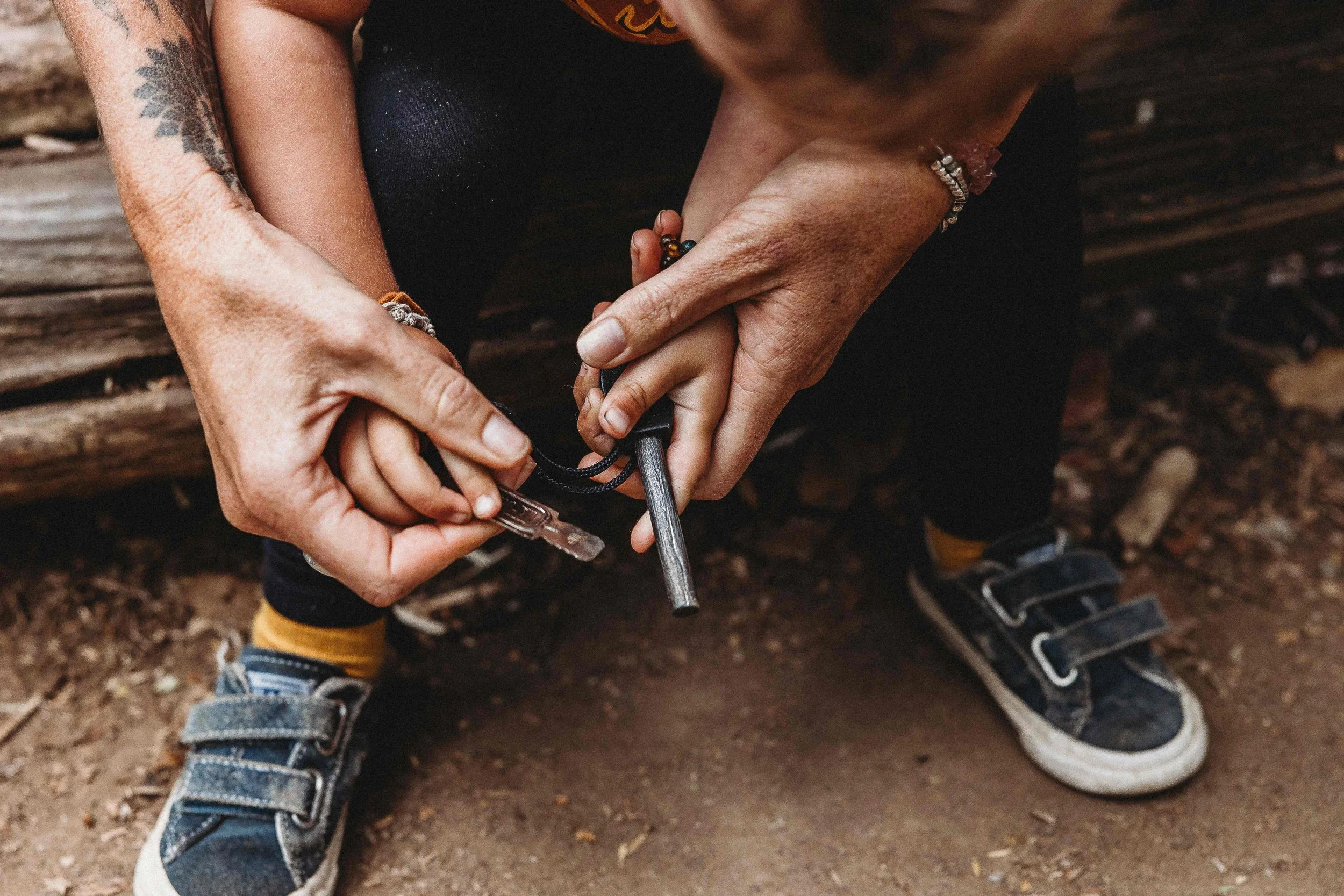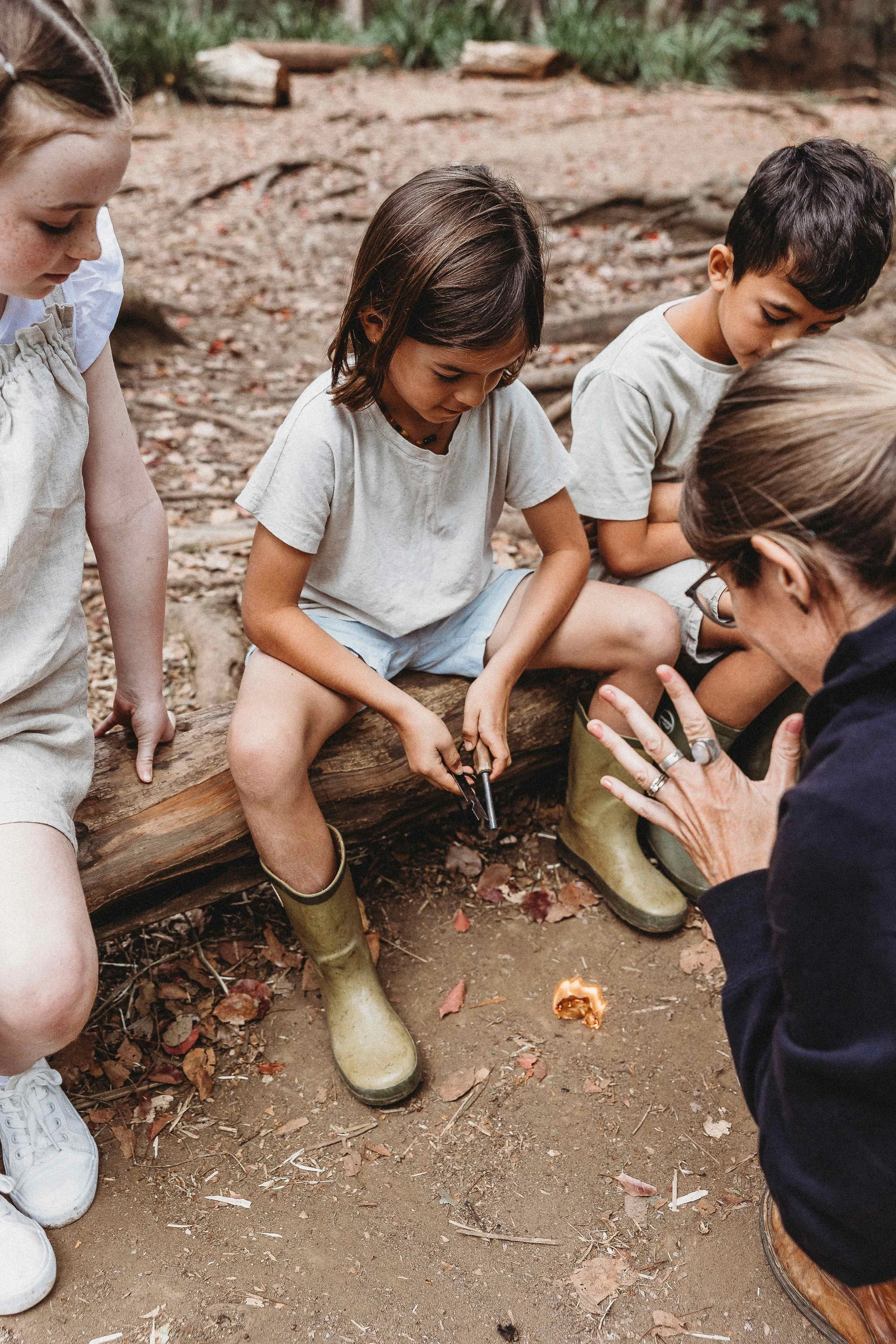Patience, Precision and Practice: 9 Great Reasons Why Kids Should Learn to Fire Strike
As parents, we often find ourselves torn between protecting our children from potential dangers and empowering them with the skills to navigate the world confidently.
One area where this conflict often arises is the topic of fire striking.
While it might seem controversial to let young kids play with fire, teaching them how to start and manage fires safely can be an incredibly beneficial and exciting aspect of nature play.
Fire is a primal element that, when respected and understood, can feed an essential part of their growth and development.
At Wildlings Forest School, we’re dedicated to creating rich and exciting experiences for children to connect with the outdoors.
Facilitating fire sessions and giving kids the skills to fire strike safely is an important aspect of risky play and a huge focus of our nature play sessions.
Plus, our explorations with fire always make for a wonderful wintry day outside with our forest friends!
THE PRIMAL CONNECTION TO FIRE
Fire has been a fundamental part of human existence for thousands of years.
Our ancestors relied on it for warmth, cooking, and protection.
This deep-rooted connection to fire is still within us, and for children, learning to harness and control fire can be a profoundly empowering experience.
It taps into their natural curiosity and fascination with this elemental force, helping them build a healthy respect for it.
DEVELOPING PRACTICAL SKILLS
1. Understanding Fire Safety
One of the first and most important lessons in fire striking is safety. Children learn about the dangers of fire, how to handle it responsibly, and what to do in case of an emergency.
These lessons are not just theoretical; they are practical skills that can keep them and others safe throughout their lives.
2. Building Confidence and Independence
Starting a fire requires patience, precision, and practice. As children learn to strike a fire successfully, they gain a sense of accomplishment and confidence.
This newfound confidence can translate into other areas of their lives, fostering a sense of independence and self-reliance.
3. Enhancing Motor Skills
The physical act of fire striking improves fine motor skills and hand-eye coordination.
Children must learn to use the striker and tinder correctly, which involves a level of dexterity that can benefit their overall physical development.
ENCOURAGING EMOTIONAL GROWTH
4. Managing Risk and Building Resilience
Allowing children to engage with fire in a controlled environment helps them learn to manage risk.
They understand the consequences of their actions and learn to approach potentially dangerous situations with caution and respect.
This kind of controlled risk-taking is essential for building resilience and problem-solving skills.
5. Fostering Patience and Persistence
Starting a fire isn't always easy; it requires patience and persistence.
Children learn to keep trying, even when their initial attempts fail. This perseverance is a valuable life skill that will serve them well in many other areas.
Starting a fire requires patience, precision, and practice.
As children learn to strike a fire successfully, they gain a sense of accomplishment and confidence.
PROMOTING COGNITIVE DEVELOPMENT
6. Stimulating Curiosity and Learning
Fire striking naturally stimulates curiosity. Children ask questions about how fire works, why certain materials burn better than others, and what they can do to improve their technique.
This curiosity leads to a deeper understanding of scientific principles such as combustion, heat transfer, and the properties of different materials.
7. Problem-Solving and Critical Thinking
Each fire striking attempt is a problem-solving exercise.
Children must think critically about the conditions needed to start a fire, adjust their methods, and learn from their mistakes.
This kind of hands-on learning is incredibly effective for cognitive development.
CREATING CONNECTION AND TRADITION
8. Bonding Time
Fire striking can be a shared activity that brings families closer together. Teaching your child how to start a fire is not just about passing on a skill; it's about spending quality time together and creating lasting memories.
9. Connecting with Nature
Learning to start a fire often takes place in natural settings. This connection to nature is vital for children's overall well-being.
It fosters a sense of stewardship for the environment and a deeper appreciation for the natural world. It’s also a fun and exciting activity to integrate into your child’s nature play adventures.
ADDRESSING THE CONTROVERSY
It's understandable for parents to have reservations about letting their children engage with fire.
However, with proper supervision, clear safety guidelines, and a controlled environment, fire striking can be a safe and immensely rewarding activity.
It's about finding the right balance between caution and empowerment.
Tips for Safe Fire Striking
1. Start with Safety Education:
Before any hands-on practice, teach your child about fire safety rules and emergency procedures.
2. Supervise Closely:
Always supervise your child closely during fire striking activities.
3. Use Appropriate Tools:
Provide child-friendly fire striking tools that are safe and easy to handle.
4. Choose a Safe Location:
Ensure the fire striking takes place in a safe, controlled environment, away from flammable materials.
5. Set Clear Boundaries:
Establish and enforce rules about when and where fire striking is allowed.
Teaching children to fire strike is more than just a survival skill; it's an enriching experience that supports their physical, emotional, and cognitive development.
It fosters confidence, patience, problem-solving abilities, and a deep respect for nature and fire itself. By embracing this ancient practice with modern safety precautions, we can help our children ignite their curiosity and grow into resilient, knowledgeable individuals.
Curious about igniting your child’s curiosity with fire striking, but unsure how to get started?
Forest school is the perfect place to learn and practice essential skills like fire striking and campfire cooking. Spend a memorable day together outdoors in a supportive environment with passionate playworkers, experienced in facilitating risky nature play experiences for kids.
Venture into the wild with us and secure your child’s spot in one of our forest school programs in Brisbane and the Sunshine Coast, Queensland, Australia.
Written by Ellen Nesbitt. Ellen is a nature play advocate and creative writer with a passion for helping families connect with the outdoors. She is dedicated to exploring ways to nurture children's creativity, independence, wellbeing and love for nature.

